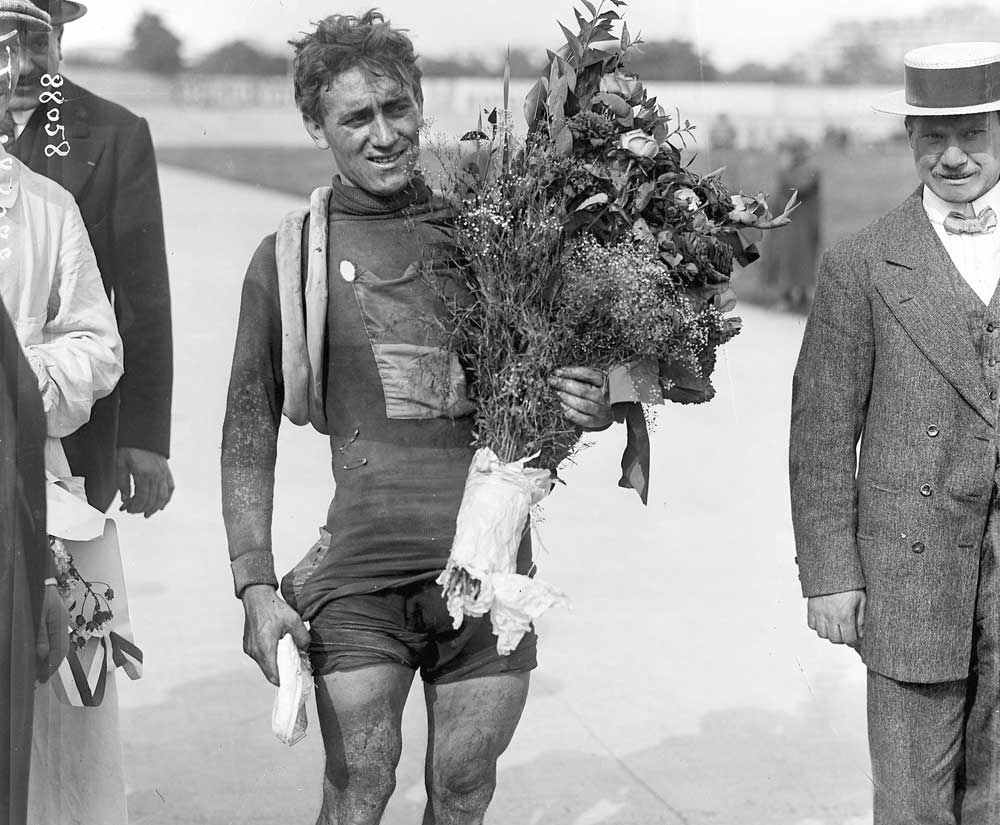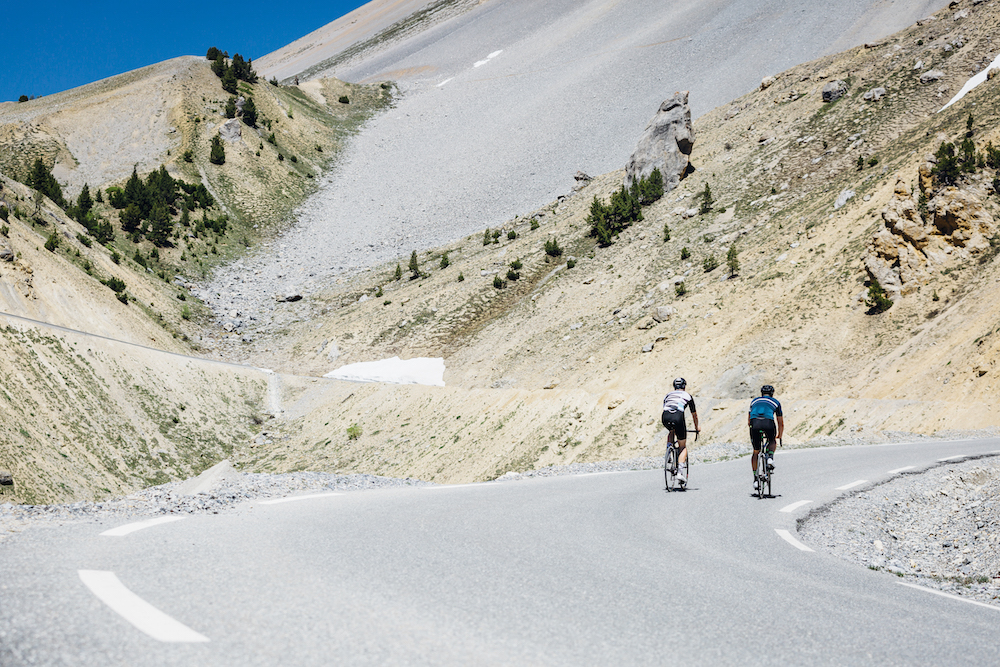The Col d’Izoard: A giant of the Tour de France
This year the Tour de France will honour the Col d’Izoard with a summit finish for the first time. What’s more, it will be the final mountain of the race. James Shrubsall investigates this giant of the Tour


When Philippe Thys finally reached the summit of the Col d’Izoard in the 1922 Tour de France, the Belgian would have stopped, but only to change gear and perhaps take on a drink.
Then he would have remounted for the treacherous descent to Briançon, where he would register his fourth of five stage wins that year.
It’s unlikely that, in the heat of the race and the chill of the altitude, he would have paused to look back across the Casse Déserte towards the steep, forested slopes and the meadows beyond from where he had just ascended, and wonder at the new legend he had just ushered in.
Ninety-five years have passed since then. In 2017, 103 Tours and 34 ascents of the Izoard later, the col will finally host a Tour de France stage finish at its summit.

On a day that echoes Thys’s exploits all those years ago, stage 18 will start in Briançon before taking on a sprawling 180km loop to the south which ultimately returns north over the Col de Vars (another Thys first) before tackling the fabled south side of the Izoard.
That there has never before been a summit finish here in all this time is almost hard to believe, for there aren’t many giants of the Tour that have missed out on this honour.
The latest race content, interviews, features, reviews and expert buying guides, direct to your inbox!
>>> The Col du Galibier: The Tour’s most iconic climb (video)
But as the years pass and the Tour becomes less bike race, more small town on spoked wheels, it becomes ever more difficult to plant that small town on a barren rock in the sky and call it an Arrivée.
The logistical hardships of such a feat were neatly illustrated when we were there recently and, having rasped our way over the crest, posed in glassy eyed relief at the summit memorial stone and staggered into the dim shop at the top and tried to pay by card for refreshments, we were told “Pas d’électricité [no electricity]” in a the sort of terse manner that suggested we weren’t the first ones to have been disappointed by this information.

The presence of strip lights on the ceiling (turned off) and a small cycling museum next door (closed) suggested this was probably a temporary state of affairs, but nevertheless, Tour de France boss Christian Prudhomme and the gang must have spent no small amount of time coming up with a reliable alternative to a 500-socket extension lead run out of the shop utility cupboard.
Steeped in cycling history
The day Thys made that first climb of the Izoard the stage began, incredibly, on the Riviera in Nice, representing a 274km sea-to-mountains epic.
Henri Desgrange, Tour de France founder and notoriously hard taskmaster, probably thought he was giving his charges a rather easy time of it at least in terms of distance; he’d already subjected them to four 400km-plus stages that year, including a brutal 482km outing from Les Sables d’Olonne to Bayonne which dispatched half the length of the country in one go.
Of the Izoard itself, the pitiless Desgrange had mused: “The task at hand is so difficult that our riders won’t think of battling any more until the end of the race.”

That Nice-Briançon route became a 1920s staple, while in the 1948 and ’49 Tours, with the Coppi-Bartali rivalry in full swing, the pair took it in turns to lead the race over the Izoard having set out from Cannes, also on the coast. It would be the last time the peloton was treated to a medicinal lungful of sea air before taking on the Izoard.
The following year in 1950, Louison Bobet, darling of the mountain, entered into the fray. He would go on to become the only rider to have led over the col three times and in 1953 he sealed overall victory on its sun-bleached slopes when he won alone by more than five minutes in Briançon.
A year later he led over again and was subsequently honoured alongside Fausto Coppi with a memorial in the Casse Déserte.

The mountain maintained a steady profile in the Tour over the next decade but regained a popularity in the Seventies not seen since the early part of the century. First blood went to — who else? — Eddy Merckx.
Locked in a one-on-one struggle on the lower slopes with Cyrille Guimard, Merckx ultimately rode the Frenchman, flailing and overgeared, off his wheel at the top of the valley before plunging into the woods alone. He soloed over the mountain and into Briançon to his fourth stage win that year.
>>> How they used to train: Eddy Merckx’s pre-1969 Tour de France week
A week later he won his fourth Tour by more than 10 minutes.
“I’d heard about the Casse Déserte, and the Fausto Coppi memorial,” said Merckx afterwards, “but I saw nothing.
I’m afraid I was rather busy.”
Three years later, in 1975, the unforgiving mountain turned on the champion, authoring a downfall that must have been unthinkable at the time.

French pretender Bernard Thévenet had secured yellow when Merckx blew catastrophically on the climb of Pra Loup on stage 15, and could do nothing the following day as, under a blazing Bastille Day sun, Thévenet distanced him in the valley meadows halfway up the Izoard.
Having ultimately finished the stage at Serre Chevalier more than two minutes ahead of the Belgian, Thévenet’s exploits were lauded by none other than Louison Bobet, who gushed: “You’re not a great champion until you’ve crossed the Col d’Izoard alone in the maillot jaune.”
Bobet died in 1983 but, along with Coppi, his spirit will be in attendance on July 20, when the mountain is likely to be approached with a new vigour — one focused on a summit finish.
“We must return the mountain to the greats,” declared Prudhomme who, clearly with one eye on its historical significance, has allotted double mountains points to the Izoard and the Izoard only this year.
Predicting a winner would be foolish and near-impossible, but the Izoard is the Tour’s final mountain rendezvous this year.
With only two flat stages and a short time trial left to race, the hot, pale tarmac of this fearsome climb is sure to play a part in deciding the champion.
Fingers crossed we see a battle of which Bobet himself would wholly approve.
Ride notes: Col d'Izoard south side
The Col d’Izoard can be climbed by bike both from the north and the south, and if you’re feeling intrepid (and, importantly, fit) you could conceivably do both in a day.
Begin in Guillestre on the south side, and once you’ve broken Instagram with summit-posed selfies, enjoy the wooded, serpentine drop into Briançon for lunch, before riding the whole thing in reverse.

Both are fine climbs, but the south side is the original, most challenging and best trodden. It begins in the small town of Guillestre, all ramshackle pastel frontages and mountain shadows.
Here, if you’re short on supplies of any kind, it’s wise to fill your pockets — we wouldn’t recommend betting on the capricious business hours of the few establishments that exist on the Izoard itself.
Following the D902 north-east away from town, the dry, scrubby landscape soon gives way to an impressive and imposing gorge. As you’re fresh at this stage and still in possession of all your faculties, you can enjoy this visual treat to the full as the road winds slowly and easily upwards under vast precipices, the urgent River Guil teeming below.
There are tunnels along this stretch too, so a rear light is a must.

After around 15 kilometres a large left-hand turn-off with an accompanying Col d’Izoard sign indicates that you are ready to begin in earnest.
While there is a noticeable and immediate increase in gradient, it’s initially still a fairly innocuous road that leads you up between meadows that seem to have been borrowed straight from The Sound of Music — the brooding scree slopes of the Casse Déserte and the austere summit air seem a world away.
Into the unknown
The road passes the occasional bar restaurant which represent your final opportunity to take on food and drink before the summit; beyond the clustered chalets of Brunissard it’s just you and the mountain streams.
At the top of the valley, following a long, steep ramp, the road swings right and takes you into the trees, where on steep, winding slopes you’ll stay until emerging blinking-eyed into the Casse Déserte four kilometres later.

Once you gain a little altitude, the view back down the valley is beautiful, near-perfect even, a definitive Alpine panorama — so however focused you might be, keep an eye out through the trees.
Eventually, the foliage thins, and a final ramp leads you to a swinging right-hander which places you centre stage in cycling’s grandest amphitheatre — the Casse Déserte.
Like a hopeful primary schooler prodded out into the spotlight in front of Cowell and friends on Britain’s Got Talent, prepare to feel no small amount of awe through the physical exertion at the towering scree slopes reaching up into the cheap seats.
A short downhill affords the legs a breather, but all too soon exertion is required again as the road points upward. At this point you pass the twin-headed Coppi-Bobet memorial stones.

These two heads of cycling state led the Tour de France over the Izoard five times between them during the Forties and Fifties, and their faces bear empathetic grimaces from which you might draw a little extra momentum.
Just a few hundred yards further on, the summit hoves into view for the first time. Squint hard and you can just make out the memorial stone and perhaps the summit shop.
It looks a way off, but long, sweeping ramps draw you quickly closer to the foot of a series of hairpins, on whose bleached and brittle grades you scale the final escarpment of the Izoard’s southern face.
After cutting his teeth on local and national newspapers, James began at Cycling Weekly as a sub-editor in 2000 when the current office was literally all fields.
Eventually becoming chief sub-editor, in 2016 he switched to the job of full-time writer, and covers news, racing and features.
He has worked at a variety of races, from the Classics to the Giro d'Italia – and this year will be his seventh Tour de France.
A lifelong cyclist and cycling fan, James's racing days (and most of his fitness) are now behind him. But he still rides regularly, both on the road and on the gravelly stuff.
